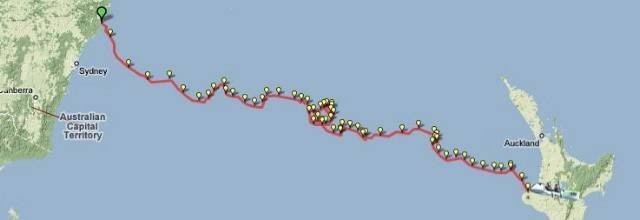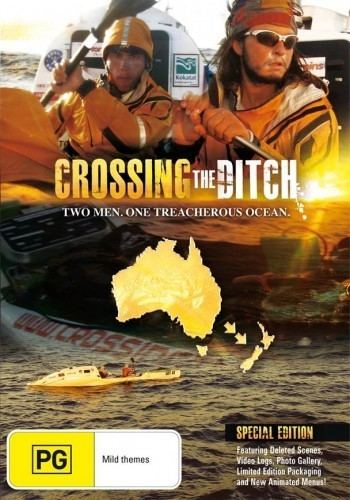 | ||
Crossing the ditch ready steady go
Thirty years after the first person rowed solo across the Tasman Sea in 1977, Crossing the Ditch was the effort of Justin Jones and James Castrission, known as Cas and Jonesy to become the first to cross the sea and travel from Australia to New Zealand by sea kayak. Setting off from Forster, New South Wales on 13 November 2007 in their custom-designed kayak Lot 41, the two-man expedition succeeded after previous attempts, including the fatal journey of Andrew McAuley, had been unsuccessful. They arrived at Ngamotu Beach, in New Plymouth, New Zealand on 13 January 2008.
Contents
- Crossing the ditch ready steady go
- Crossing the ditch james castrission at tedxathens
- Team
- Design and construction of Lot 41
- Journey
- The Ditch
- Lot 41
- Other Trans Tasman Crossings
- References

The expedition holds the world record for "the longest trans-oceanic expedition in a double kayak by two expeditioners". A significant aspect of this undertaking was the use of the internet to allow the public to track the progress of Lot 41 in real time, and message the crew. Photographs and podcasts from the crew were made available just hours after they had been transmitted from the craft.

Crossing the ditch james castrission at tedxathens
Team

The crew of Lot 41 were James Castrission and Justin Jones, two Australians from Sydney, New South Wales. They attended school at Knox Grammar School together and later kayaked across Bass Strait, as well as being the first to paddle the length of the Murray River, a distance of 2,560 kilometres (1,590 mi).

In addition to the crew of the kayak, many others, both in Australia and New Zealand, helped in the preparation for the voyage as well as providing constant support from land.
Design and construction of Lot 41
The kayak Lot 41 was designed for the trans-Tasman crossing by Rob Feloy, who had designed the kayak for Peter Bray's trans-Atlantic Crossing approximately six years earlier. The Lot 41 design includes two cockpits, a cabin at the stern of the craft, a large water tank and storage for over 60 days of food for the two kayakers. An array of solar panels was incorporated into the design in order to charge the batteries used to power communication systems, bilge pumps and a water desalination unit. The fibreglass kayak was built in Australia in 2005, and was fitted with support systems including emergency beacons, satellite phone, global tracking system, and GPS.
Journey

Cas and Jonesy departed Forster, Australia at 1:30 pm AEST on 13 November 2007. By 2 December, they had reached the vector halfway point, 1,039.5 kilometres (645.9 mi; 561.3 nmi) from Forster and 1,058.24 kilometres (657.56 mi; 571.40 nmi) from Auckland. Their distance over land, which measures the actual path travelled by the kayak and not a straight line, was 1,372 kilometres (853 mi; 741 nmi).

One of the difficulties faced by Lot 41 were strong headwinds. These winds on their own would have made the crossing more difficult, however the design of the cabin at the stern of the kayak compounded the issue. When the winds blew from behind, the cabin presented a smooth, aerodynamic shape which reduced the tailwind advantage. In contrast, headwinds met a nearly vertical cabin entrance, which acted as a large sail fighting against the paddlers.
The initial plans for the crossing had Lot 41 making port at Auckland. Conditions encountered during the crossing, including strong winds and currents, saw them travel in circles for some time and added almost 1,200 kilometres (750 mi; 650 nmi) to their journey. As they approached the New Zealand coastline, the decision was made to head to New Plymouth instead.
Cas and Jonesy paddled into New Plymouth harbour on 13 January 2008, landing on Ngamotu Beach at 12:20 pm NZST. The crossing took 60 days, 20 hours and 50 minutes.
Lot 41, along with a collection of associated artifacts, was later donates by the adventurers to the Australian National Maritime Museum.
The Ditch
The Tasman Sea has for many years been referred to as "The Ditch" by Australians and New Zealanders. The exact etymology for this term is uncertain, however when traveling between Australia and New Zealand, it is commonly referred to as "crossing the ditch".
Lot 41
Lot 41 is named after the auction lot number of the race horse "Phar Lap", widely considered to be Australia and New Zealand's most famous racehorse. Born and bred in New Zealand, the thoroughbred destined to be Australia's wonder horse was known only as Lot 41 when he was sold at the 1928 National Yearling Sales near Wellington. Following his purchase by a Sydney trainer, the thoroughbred made the trans-Tasman crossing to Australia, where he became famous.
